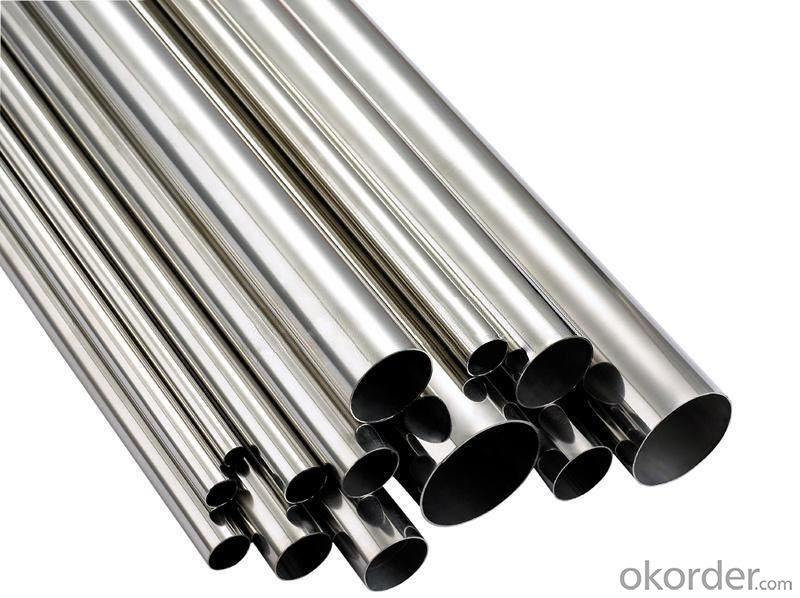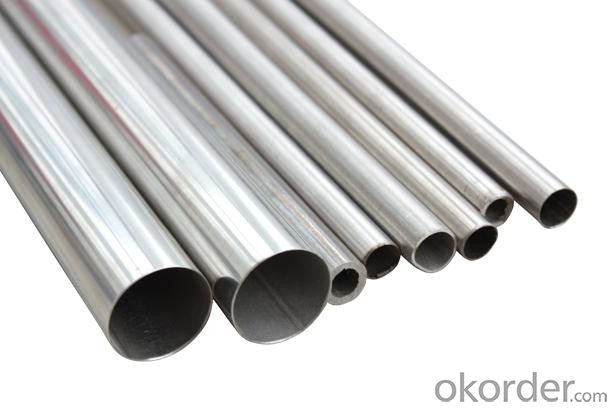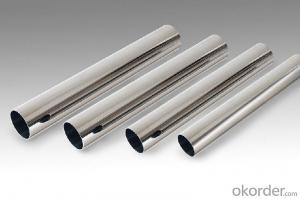Stainless Steel Sanitary Tubing ISO 2037/DIN11850
- Loading Port:
- Ningbo
- Payment Terms:
- TT OR LC
- Min Order Qty:
- 25 m.t.
- Supply Capability:
- 5000 m.t./month
OKorder Service Pledge
OKorder Financial Service
You Might Also Like
1、Structure of Stainless Steel Sanitary Tubing ISO 2037/DIN11850 Description:
Stainless steel sanitary tubing is often used in applications found in the biotech, pharma, and food/beverage industries. Sanitary tubing must be somewhat inert not to react to the chemical that pass through the tubing itself. Sanitary tubing is used in conjunction with stainless sanitary fittings.2、Main Features of the Stainless Steel Sanitary Tubing ISO 2037/DIN11850:
• High manufacturing accuracy
• High strength
• Small inertia resistance
• Good visual effect
•Reasonable price
3、Stainless Steel Sanitary Tubing ISO 2037/DIN11850 Images:



4、Stainless Steel Sanitary Tubing ISO 2037/DIN11850 Specification:
Size:
| Outside diameter | Thickness(mm) | |||||
| (inch) | (mm) | 1 | 1.5 | 2 | 2.5 | 3 |
| 3/4′ | 19.1 | |||||
| 7/8′ | 22.2 | |||||
| 1′ | 25.4 | |||||
| 1-1/8′ | 28.6 | |||||
| 1-1/4′ | 31.8 | |||||
| 1-1/2′ | 38.1 | |||||
| 40 | ||||||
| 45 | ||||||
| 2 | 50.8 | |||||
| 52 | ||||||
| 2-1/4′ | 57.15 | |||||
| 2-1/8′ | 60.3 | |||||
| 2-1/2′ | 63.5 | |||||
| 70 | ||||||
| 3 | 76.2 | |||||
| 85 | ||||||
| 3-1/2′ | 88.9 | |||||
| 4′ | 101.6 | |||||
| 4-1/8′ | 104.78 | |||||
| 4-1/4′ | 107.95 | |||||
| 4-1/2′ | 114.3 | |||||
| 5-1/4′ | 133.35 | |||||
| 6-1/4′ | 158.75 | |||||
| 8-5/8′ | 219.08 | |||||
Tolerances on dimensions table:
| Outside diameter | Thickness | Length | |
| <25.40mm | ±0.13mm | ±10.00% | OD<101.60mm +3.20mm -0mm OD≥101.60mm +4.80 -0mm |
| ≥25.40mm~50.80mm | ±0.20mm | ||
| ≥50.80mm~76.20mm | ±0.25mm | ||
| ≥76.20mm~101.60mm | ±0.38mm | ||
| ≥101.60mm~139.70mm | ±0.38mm | ||
| ≥139.70mm~203.20mm | ±0.76mm | ||
| ≥203.20mm~304.80mm | ±1.27mm | ||
5、FAQ of Stainless Steel Sanitary Tubing ISO 2037/DIN11850:
①How is the quality of your products?
Our products are manufactured strictly according to national and internaional standard, and we take a test on every pipe before delivered out. If you want see our quality certifications and all kinds of testing report, please just ask us for it.
Guaranteed: If products’ quality don’t accord to discription as we give or the promise before you place order, we promise 100% refund.
②How about price?
Yes, we are factory and be able to give you lowest price below market one, and we have a policy that “ for saving time and absolutely honest business attitude, we quote as lowest as possible for any customer, and discount can be given according to quantity”,if you like bargain and factory price is not low enough as you think, just don’t waste your time.Please trust the quotation we would give you, it is professional one.
③Why should you chose us?
Chose happens because of quality, then price, We can give you both.Additionally, we can also offer professional products inquiry, products knowledge train(for agents), smooth goods delivery, exellent customer solution proposals.Our service formula: good quality+good price+good service=customer’s trust
SGS test is available, customer inspection before shipping is welcome, third party inspection is no problem.
Any question, pls feel free to contact us !
- Q:What are the common standards for stainless steel pipes?
- The common standards for stainless steel pipes vary depending on the specific application and industry. However, there are several widely recognized standards that are commonly used in the manufacturing and specification of stainless steel pipes. One of the most widely used standards is ASTM International, which sets the standards for various materials, including stainless steel. ASTM A312/A312M is the standard specification for seamless, welded, and heavily cold worked austenitic stainless steel pipes. This standard covers a wide range of pipe sizes and grades, including TP304, TP316, TP321, and more. Another commonly referenced standard is the American National Standards Institute (ANSI) standards. ANSI B36.19 specifies the dimensions, tolerances, and materials for stainless steel pipes. This standard covers both seamless and welded stainless steel pipes and includes a range of sizes and schedules. In addition to these standards, there are also specific standards for certain industries. For example, the American Petroleum Institute (API) has standards such as API 5L for line pipes used in the oil and gas industry. These standards outline the requirements for materials, dimensions, and testing for stainless steel pipes used in specific applications. Other standards organizations, such as the International Organization for Standardization (ISO) and the European Committee for Standardization (EN), also provide standards for stainless steel pipes. ISO 1127, for example, specifies the dimensions and tolerances for stainless steel pipes used in general purposes. It is important to note that these standards are continuously updated and revised based on technological advancements and industry needs. Therefore, it is crucial to consult the latest versions of these standards to ensure compliance and quality in the manufacturing and use of stainless steel pipes.
- Q:How do you prevent stress corrosion cracking in stainless steel pipes?
- To prevent stress corrosion cracking in stainless steel pipes, there are various precautions that can be taken: 1. Material selection: Opt for a stainless steel grade that has a high resistance to stress corrosion cracking. Typically, austenitic stainless steel grades like 304 and 316 are preferred due to their excellent corrosion and cracking resistance. 2. Proper fabrication and welding: Ensure that the welding procedures used during fabrication are suitable for stainless steel and minimize the introduction of residual stresses. This involves employing appropriate welding techniques, maintaining the right heat input, and implementing post-weld heat treatment if necessary. 3. Avoid exposure to corrosive environments: Shield stainless steel pipes from exposure to aggressive chemicals, high chloride concentrations, and other corrosive substances. Regularly inspect the environment and take necessary measures to prevent contact between the pipes and corrosive agents. 4. Control operating conditions: Steer clear of subjecting stainless steel pipes to excessive tensile stresses or temperatures that can encourage stress corrosion cracking. This can be achieved by maintaining suitable operating conditions, such as controlling pressure, temperature, and flow rates within recommended limits. 5. Regular inspection and maintenance: Conduct routine inspections to detect any signs of stress corrosion cracking. This may include visual inspections, non-destructive testing techniques (e.g., ultrasonic testing), or corrosion monitoring. If any signs of stress corrosion cracking are identified, immediate action should be taken to repair or replace the affected pipe sections. 6. Proper cleaning and maintenance: Keep stainless steel pipes clean and devoid of contaminants that can accelerate corrosion. Regularly follow cleaning and maintenance practices, including the removal of any deposits or foreign materials that may promote stress corrosion cracking. In conclusion, preventing stress corrosion cracking in stainless steel pipes necessitates a combination of appropriate material selection, fabrication techniques, environmental control, regular inspections, and suitable maintenance practices. By implementing these measures, the risk of stress corrosion cracking can be significantly minimized, thereby ensuring the longevity and reliability of stainless steel pipes.
- Q:Can stainless steel pipes be used for underground applications?
- Yes, stainless steel pipes can be used for underground applications. Stainless steel is highly resistant to corrosion and can withstand the harsh conditions found underground, making it a suitable choice for various underground applications such as drainage systems, sewage pipes, and water supply lines.
- Q:What are the temperature limits for stainless steel pipes?
- The temperature limits for stainless steel pipes depend on the specific grade of stainless steel being used. Generally, stainless steel pipes can withstand high temperatures, making them suitable for a wide range of applications. For austenitic stainless steel grades like 304 and 316, the temperature limits typically range from -250°C to 925°C (-418°F to 1,700°F). These grades exhibit excellent resistance to corrosion and can maintain their mechanical properties at elevated temperatures. Ferritic stainless steel grades, such as 430, have slightly lower temperature limits, typically ranging from -150°C to 815°C (-238°F to 1,499°F). While these grades offer good resistance to corrosion, they have lower thermal conductivity and may experience reduced strength at high temperatures compared to austenitic grades. It is important to note that the temperature limits can vary based on factors such as pipe thickness, surface condition, and the specific application. It is recommended to consult the manufacturer or relevant design codes to determine the precise temperature limits for a specific stainless steel grade and application.
- Q:What are the different types of stainless steel pipe bends?
- There are several different types of stainless steel pipe bends, including 45-degree, 90-degree, and 180-degree bends. Additionally, there are short radius and long radius bends, as well as U-bends and J-bends. These variations allow for flexibility in designing and connecting stainless steel piping systems to fit specific needs and spatial constraints.
- Q:Can stainless steel pipes be used for refrigeration systems?
- Indeed, refrigeration systems can utilize stainless steel pipes. Stainless steel, being an exceedingly robust material, exhibits exceptional resistance against corrosion, rendering it perfectly suitable for deployment in refrigeration systems where both moisture and low temperatures are prevalent. Moreover, stainless steel pipes boast remarkable thermal conductivity, facilitating efficient and effective heat transfer throughout the entire system. Furthermore, stainless steel pipes are effortlessly cleanable and maintainable, while also demonstrating the capacity to withstand significant pressure, thereby making them highly appropriate for deployment in refrigeration systems necessitating unwavering and enduring performance.
- Q:What is the difference between 904L and 2205 stainless steel pipes?
- 904L and 2205 stainless steel pipes differ in various aspects. Firstly, their composition varies significantly. 904L stainless steel is a high alloy austenitic stainless steel with elevated levels of chromium, nickel, and molybdenum. It also has a low carbon content, granting it remarkable resistance to corrosion and pitting. Conversely, 2205 stainless steel is a duplex stainless steel that combines austenite and ferrite phases. It contains lower amounts of chromium and nickel compared to 904L, but boasts higher levels of molybdenum and nitrogen. Secondly, the mechanical properties of these steels differ. 904L stainless steel exhibits exceptional toughness and high strength, making it suitable for applications in aggressive environments such as chemical processing plants and offshore oil and gas platforms. Conversely, 2205 stainless steel possesses good overall mechanical properties, including high tensile and yield strength. It is commonly utilized in industries like marine, paper, and pulp, wherein resistance to stress corrosion cracking is crucial. Additionally, their resistance to corrosion separates them further. Although both steels are corrosion-resistant, 904L stainless steel showcases remarkable resistance to a wide range of corrosive environments, including sulfuric acid, hydrochloric acid, and saltwater. This makes it an ideal choice for industries that demand extreme corrosion resistance. On the other hand, 2205 stainless steel, while not as corrosion-resistant as 904L, still offers good resistance to many corrosive substances, rendering it suitable for various applications. Cost constitutes another distinguishing factor between these steels. Due to its high alloy content and superior properties, 904L stainless steel generally carries a higher price tag than 2205 stainless steel. Therefore, the selection between the two will depend on the specific requirements of the application and the allocated budget. In conclusion, the main disparities between 904L and 2205 stainless steel pipes emerge in their composition, mechanical properties, corrosion resistance, and cost. Comprehending these distinctions aids in selecting the appropriate stainless steel pipe for a given application.
- Q:Can stainless steel pipes be coated for additional protection?
- Yes, stainless steel pipes can be coated for additional protection. Coatings such as epoxy, polyethylene, or fusion-bonded epoxy can be applied to stainless steel pipes to enhance corrosion resistance and prolong their lifespan.
- Q:Can stainless steel pipes be insulated with polyimide?
- Yes, stainless steel pipes can be insulated with polyimide. Polyimide is a highly versatile and durable material that can withstand high temperatures, making it suitable for insulating stainless steel pipes.
- Q:Can stainless steel pipes be insulated with polyethylene-terephthalate glycol?
- No, stainless steel pipes cannot be insulated with polyethylene-terephthalate glycol.
1. Manufacturer Overview |
|
|---|---|
| Location | |
| Year Established | |
| Annual Output Value | |
| Main Markets | |
| Company Certifications | |
2. Manufacturer Certificates |
|
|---|---|
| a) Certification Name | |
| Range | |
| Reference | |
| Validity Period | |
3. Manufacturer Capability |
|
|---|---|
| a)Trade Capacity | |
| Nearest Port | |
| Export Percentage | |
| No.of Employees in Trade Department | |
| Language Spoken: | |
| b)Factory Information | |
| Factory Size: | |
| No. of Production Lines | |
| Contract Manufacturing | |
| Product Price Range | |
Send your message to us
Stainless Steel Sanitary Tubing ISO 2037/DIN11850
- Loading Port:
- Ningbo
- Payment Terms:
- TT OR LC
- Min Order Qty:
- 25 m.t.
- Supply Capability:
- 5000 m.t./month
OKorder Service Pledge
OKorder Financial Service
Similar products
New products
Hot products
Hot Searches
Related keywords




























